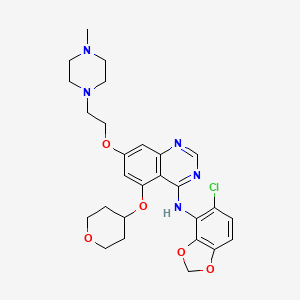Drug Information
Drug (ID: DG00214) and It's Reported Resistant Information
| Name |
Saracatinib
|
||||
|---|---|---|---|---|---|
| Synonyms |
H8H; AZD-0530; Saracatinib, AZD-0530, AZD0530; N-(5-Chloro-1,3-benzodioxol-4-yl)-7-(2-(4-methylpiperazin-1-yl)ethoxy)-5-(tetrahydro-2H-pyran-4-yloxy)quinazolin-4-amine
Click to Show/Hide
|
||||
| Indication |
In total 3 Indication(s)
|
||||
| Structure |

|
||||
| Target | Proto-oncogene c-Src (SRC) | SRC_HUMAN | [1] | ||
| Tyrosine-protein kinase ABL1 (ABL) | ABL1_HUMAN | [1] | |||
| Click to Show/Hide the Molecular Information and External Link(s) of This Drug | |||||
| Formula |
C27H32ClN5O5
|
||||
| IsoSMILES |
CN1CCN(CC1)CCOC2=CC3=C(C(=C2)OC4CCOCC4)C(=NC=N3)NC5=C(C=CC6=C5OCO6)Cl
|
||||
| InChI |
1S/C27H32ClN5O5/c1-32-6-8-33(9-7-32)10-13-35-19-14-21-24(23(15-19)38-18-4-11-34-12-5-18)27(30-16-29-21)31-25-20(28)2-3-22-26(25)37-17-36-22/h2-3,14-16,18H,4-13,17H2,1H3,(H,29,30,31)
|
||||
| InChIKey |
OUKYUETWWIPKQR-UHFFFAOYSA-N
|
||||
| PubChem CID | |||||
| TTD Drug ID | |||||
| DrugBank ID | |||||
Type(s) of Resistant Mechanism of This Drug
Drug Resistance Data Categorized by Their Corresponding Diseases
ICD-02: Benign/in-situ/malignant neoplasm
| Drug Sensitivity Data Categorized by Their Corresponding Mechanisms | ||||
|
|
||||
| Key Molecule: hsa-mir-106a | [2] | |||
| Molecule Alteration | Expression | Up-regulation |
||
| Sensitive Disease | Lung cancer [ICD-11: 2C25.5] | |||
| Experimental Note | Revealed Based on the Cell Line Data | |||
| Cell Pathway Regulation | Cell apoptosis | Activation | hsa04210 | |
| miR106a/ULk1 signaling pathway | Inhibition | hsa05206 | ||
| In Vitro Model | A549 cells | Lung | Homo sapiens (Human) | CVCL_0023 |
| H460 cells | Lung | Homo sapiens (Human) | CVCL_0459 | |
| H1299 cells | Lung | Homo sapiens (Human) | CVCL_0060 | |
| Experiment for Molecule Alteration |
qPCR | |||
| Experiment for Drug Resistance |
Resazurin conversion assay | |||
| Mechanism Description | Src inhibition results in autophagy activation in NSCLC cell lines. Combining Src with autophagy inhibition results in significant cell death. Induction of ULk1 upon Scr inhibition allows for autophagy activation. Src inhibition causes induction of the ULk1 targeting microRNA-106a. Expression of the "oncogenic" miR-106a sensitizes NSCLC cells to Src inhibition. | |||
|
|
||||
| Key Molecule: Serine/threonine-protein kinase ULK1 (ULK1) | [2] | |||
| Molecule Alteration | Expression | Down-regulation |
||
| Sensitive Disease | Lung cancer [ICD-11: 2C25.5] | |||
| Experimental Note | Revealed Based on the Cell Line Data | |||
| Cell Pathway Regulation | Cell apoptosis | Activation | hsa04210 | |
| miR106a/ULk1 signaling pathway | Inhibition | hsa05206 | ||
| In Vitro Model | A549 cells | Lung | Homo sapiens (Human) | CVCL_0023 |
| H460 cells | Lung | Homo sapiens (Human) | CVCL_0459 | |
| H1299 cells | Lung | Homo sapiens (Human) | CVCL_0060 | |
| Experiment for Molecule Alteration |
Western blot analysis | |||
| Experiment for Drug Resistance |
Resazurin conversion assay | |||
| Mechanism Description | Src inhibition results in autophagy activation in NSCLC cell lines. Combining Src with autophagy inhibition results in significant cell death. Induction of ULk1 upon Scr inhibition allows for autophagy activation. Src inhibition causes induction of the ULk1 targeting microRNA-106a. Expression of the "oncogenic" miR-106a sensitizes NSCLC cells to Src inhibition. | |||
| Drug Sensitivity Data Categorized by Their Corresponding Mechanisms | ||||
|
|
||||
| Key Molecule: hsa-miR-19b-3p | [1] | |||
| Molecule Alteration | Expression | Up-regulation |
||
| Sensitive Disease | Breast cancer [ICD-11: 2C60.3] | |||
| Experimental Note | Revealed Based on the Cell Line Data | |||
| Cell Pathway Regulation | Cell invasion | Activation | hsa05200 | |
| Cell migration | Activation | hsa04670 | ||
| Cell viability | Inhibition | hsa05200 | ||
| PI3K/AKT signaling pathway | Inhibition | hsa04151 | ||
| In Vitro Model | MCF-7 cells | Breast | Homo sapiens (Human) | CVCL_0031 |
| SkBR3 cells | Breast | Homo sapiens (Human) | CVCL_0033 | |
| MDA-MB-231 cells | Breast | Homo sapiens (Human) | CVCL_0062 | |
| BT474 cells | Breast | Homo sapiens (Human) | CVCL_0179 | |
| Experiment for Molecule Alteration |
RT-PCR | |||
| Experiment for Drug Resistance |
MTT assay; Transwell assay; Flow cytometry assay | |||
| Mechanism Description | miR-19b-3p increases saracatinib sensitivity by inhibiting the PI3k/Akt pathway and miR-19b-3p directly bound to the 3'-UTR of PIk3CA and inhibited PIk3CA expression. | |||
|
|
||||
| Key Molecule: PI3-kinase alpha (PIK3CA) | [1] | |||
| Molecule Alteration | Expression | Down-regulation |
||
| Sensitive Disease | Breast cancer [ICD-11: 2C60.3] | |||
| Experimental Note | Revealed Based on the Cell Line Data | |||
| Cell Pathway Regulation | Cell apoptosis | Activation | hsa04210 | |
| Cell invasion | Inhibition | hsa05200 | ||
| Cell viability | Inhibition | hsa05200 | ||
| PI3K/AKT signaling pathway | Inhibition | hsa04151 | ||
| In Vitro Model | MCF-7 cells | Breast | Homo sapiens (Human) | CVCL_0031 |
| SkBR3 cells | Breast | Homo sapiens (Human) | CVCL_0033 | |
| MDA-MB-231 cells | Breast | Homo sapiens (Human) | CVCL_0062 | |
| BT474 cells | Breast | Homo sapiens (Human) | CVCL_0179 | |
| Experiment for Molecule Alteration |
Western blot analysis | |||
| Experiment for Drug Resistance |
MTT assay; Transwell assay; Flow cytometry assay | |||
| Mechanism Description | miR-19b-3p increases saracatinib sensitivity by inhibiting the PI3k/Akt pathway and miR-19b-3p directly bound to the 3'-UTR of PIk3CA and inhibited PIk3CA expression. | |||
References
If you find any error in data or bug in web service, please kindly report it to Dr. Sun and Dr. Zhang.
